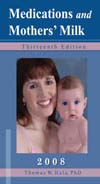
| หนังสือ-Medication&Mother's Milk
Medications and Mothers' Milk 2008 is a comprehensive reference on the impact of currently used medications on breastfeeding mothers and infants. Written by renowned clinical pharmacologist, Dr. Thomas W. Hale, this thousand plus page book is packed with information on more than 814 drugs, vitamins, herbs, and vaccines. It includes tables on radioisotopes, radiocontrast agents, and common cold remedies. Some of the new features added to Medications and Mothers' Milk 2008, thirteenth edition include: Each drug entry includes the drug name and generic name; common trade names used in Canada, Australia, and the United Kingdom; uses of the drug; AAP recommendations on the drug; a drug monograph that describes what is currently known about the drug, its ability to enter milk, the concentration in milk at set time intervals, and other parameters that are important to a clinical consultant; pregnancy risk category; lactation risk category; theoretic infant dose; relative infant dose; adult concerns; pediatric concerns; drug interactions; alternative drugs that may be suitable choices; adult dosage; and a table that includes (when known) adult half life (T ½ ) of the medication, pediatric half life (PHL) of the medication, milk/plasma ratio (M/P), the time interval from administration of the drug until it reaches the highest level in the mother's plasma or peak time to max (Tmax), percentage of maternal protein binding (PB), oral bioavailability (Oral), the volume of distribution (Vd), the pH at which the drug is equally ionic and nonionic (pKa), and the molecular weight (MW) of the medication. Armed with the information in Medications and Mothers' Milk 2008, a clinician can make an educated decision about the appropriateness of a drug for an individual mother and baby based on their medical history. Health providers can use this text to share vital information with new mothers and their physicians on how medications affect breastfeeding |









